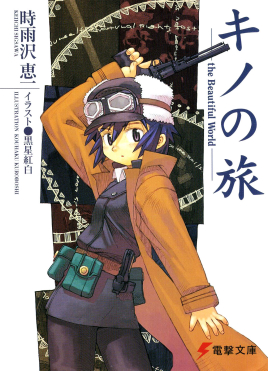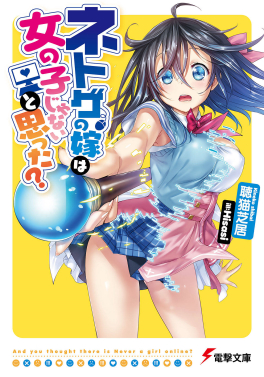Related Research Articles

Shakugan no Shana, also known simply as Shana (シャナ), is a Japanese light novel series written by Yashichiro Takahashi with illustrations by Noizi Ito. ASCII Media Works published 27 novels from November 2002 to November 2023 under their Dengeki Bunko imprint. The story focuses on Yuji Sakai, a high school boy who becomes involved in an age-old conflict between forces of balance and imbalance in existence; in the process, he befriends a fighter for the balancing force and names her "Shana". The series also incorporates fantasy and slice of life elements.

A Certain Magical Index is a Japanese light novel series written by Kazuma Kamachi and illustrated by Kiyotaka Haimura, which has been published by ASCII Media Works under their Dengeki Bunko imprint since April 2004 in a total of three separate series. The first ran from April 2004 to October 2010, the second from March 2011 to July 2019, and the third from February 2020 to present.

ASCII Media Works, formerly ASCII Media Works, Inc., is a Japanese publisher and brand company of Kadokawa Future Publishing headquartered in Nishi-Shinjuku, Shinjuku, Tokyo, Japan. It originally formed on April 1, 2008, as a result of a merger between ASCII Corporation and MediaWorks where MediaWorks legally absorbed ASCII. Despite this, the former president and CEO of ASCII, Kiyoshi Takano, became the first president and CEO of ASCII Media Works. It became an internal division of Kadokawa Corporation on October 1, 2013.
MediaWorks, Inc. was a Japanese publishing company in the Kadokawa Group known for their Dengeki brand magazines and book labels. These included such well-known magazines as Dengeki Daioh, and Dengeki G's Magazine, along with MediaWorks' main light novel publishing imprint Dengeki Bunko. The company was merged with ASCII on April 1, 2008, and became ASCII Media Works. They mainly catered to the Japanese male otaku crowd, covering such topics as anime, light novels, manga, plastic modelling, and visual novels. However, MediaWorks had published three magazines targeted towards females—Comic Sylph, Dengeki Girl's Style, and Character Parfait—but each one was a special edition version of another magazine. MediaWorks ran yearly contests for original novel and manga submissions, such as the light novel Dengeki Novel Prize contest.

Kazuma Kamachi is the pen name of a Japanese author who has published over 100 light novel volumes. He is best known for the creation of the A Certain Magical Index franchise which, as of 2019, has sold over 30 million copies worldwide and has been licensed in North America by Yen Press with the first novel being released in Q4 2014.

Kino's Journey —the Beautiful World—, shortened to Kino's Journey, is a Japanese light novel series written by Keiichi Sigsawa, with illustrations by Kouhaku Kuroboshi. The series follows a traveler named Kino and her talking motorcycle named Hermes, as they explore countries with unique customs and people around a mysterious world, only spending three days at each location. The series originally started serialization in volume five of MediaWorks' now-defunct light novel magazine Dengeki hp on March 17, 2000. The first volume of the series was published on July 10, 2000 by ASCII Media Works under their Dengeki Bunko publishing imprint. As of November 2020, 23 volumes have been published.

Horizon in the Middle of Nowhere is a Japanese light novel series written by Minoru Kawakami and illustrated by Satoyasu. The series is set in the distant future when Japan has been conquered by other countries and divided up into feudal territories. The series is part of a six-stage chronicle universe, with Minoru's other light novels encompassing the other five. A 13-episode anime adaptation by Sunrise aired between October and December 2011. A 13-episode second season aired between July and September 2012. Both seasons have been licensed and released on DVD and Blu-ray by Sentai Filmworks in North America and Manga Entertainment in the UK. A video game adaptation for the PlayStation Portable titled Horizon in the Middle of Nowhere Portable was developed by Tenky, and was released in Japan on April 25, 2013.
Buriki (ブリキ) is a Japanese illustrator currently living in Osaka Prefecture. He is the illustrator of the light novel series Boku wa Tomodachi ga Sukunai and Ground Control to Psychoelectric Girl. In 2012, he won the Kono Light Novel ga Sugoi! award as best illustrator.

Dengeki Bunko: Fighting Climax is a 2D arcade fighting game developed by Ecole Software and French Bread and published by Sega. The game celebrates the 20th anniversary of ASCII Media Works' Dengeki Bunko imprint, featuring various characters from light novels published under the imprint. The game was first released in Japanese arcades in March 2014, and later released on PlayStation 3 and PlayStation Vita on November 13, 2014. The console version was released in North America and Europe in October 2015. The game's theme song is "Belief" by Mami Kawada.

And You Thought There Is Never a Girl Online? is a Japanese light novel series, written by Shibai Kineko and illustrated by Hisasi. ASCII Media Works has published twenty-three volumes since 2013 under their Dengeki Bunko imprint. A manga adaptation with art by Kazui Ishigami was serialized in ASCII Media Works' seinen manga magazine Dengeki G's Comic from August 30, 2014, to September 29, 2018, and has been collected in eight tankōbon volumes. An anime television series adaptation by Project No.9 aired from April 7, 2016, to June 23, 2016.

Alderamin on the Sky is a Japanese light novel series, written by Bokuto Uno and illustrated by Sanbasō and Ryūtetsu between 2012 and 2018. A manga based on the series, written by Taiki Kawakami, is published in Dengeki Maoh. An anime adaptation produced by Madhouse and directed by Tetsuo Ichimura aired from July 9 to September 30, 2016.

Eromanga Sensei is a Japanese light novel series written by Tsukasa Fushimi and illustrated by Hiro Kanzaki. ASCII Media Works has published thirteen volumes in the series under its Dengeki Bunko imprint from December 2013 to August 2022. A manga adaptation illustrated by Rin has been serialized in Dengeki Daioh from May 2014 to May 2021. An anime adaptation produced by A-1 Pictures aired from April to June 2017.

Attack on Titan: Harsh Mistress of the City is a Japanese light novel series written by Ryō Kawakami and illustrated by Range Murata, based on the manga Attack on Titan by Hajime Isayama. The series is published by Kodansha in Japan and by Vertical in North America.

Grimoire of Zero is a Japanese light novel series written by Kakeru Kobashiri and illustrated by Yoshinori Shizuma. The light novel won the Grand Prize at the 20th annual Dengeki Novel Awards. ASCII Media Works has published it in eleven volumes from February 2014 to December 10, 2017. The series has received a manga adaptation illustrated by Takashi Iwasaki. A spin-off manga series, Zero kara Hajimeru Mahō no Sho Nano! (ゼロから始める魔法の書なの) has also been published and illustrated by Yasuoka. An anime television series adaptation by White Fox aired between April 10, 2017 and June 26, 2017.

The Misfit of Demon King Academy: History's Strongest Demon King Reincarnates and Goes to School with His Descendants, also known simply as The Misfit of Demon King Academy or Demon King Academy, is a Japanese light novel series written by Shu and illustrated by Yoshinori Shizuma. The series originally began as a web novel in April 2017 on the user-generated novel publishing website Shōsetsuka ni Narō when it was later acquired by ASCII Media Works, which officially began to publish it in March 2018. A manga adaptation by Kayaharuka was serialized online from July 2018 to July 2021, when it ended due to the author's death. An anime television series adaptation produced by Silver Link aired from July to September 2020. A second season aired from January 2023 to July 2024.
Eiji Mikage is a Japanese novelist.

Danjo no Yūjō wa Seiritsu Suru? is a Japanese light novel series written by Nana Nanana and illustrated by Parum. It began publication in January 2021 under ASCII Media Works' Dengeki Bunko imprint. As of August 2024, nine volumes have been released. A manga adaptation illustrated by Kamelie has been serialized in ASCII Media Works' shōnen manga magazine Dengeki Daioh since August 2021, with its chapters collected into three tankōbon volumes as of December 2023. An anime television series adaptation produced by J.C.Staff is set to premiere in 2025.

The Many Sides of Voice Actor Radio is a Japanese light novel series written by Kō Nigatsu and illustrated by Saba Mizore. It began publication in February 2020 under ASCII Media Works' Dengeki Bunko imprint. As of June 2024, eleven volumes have been released. A manga adaptation illustrated by Umemi Makimoto has been serialized in ASCII Media Works' seinen manga magazine Dengeki Maoh since March 2020, with its chapters collected into four tankōbon volumes as of June 2024. An anime television series adaptation produced by Connect aired from April to June 2024.
References
- ↑ "エッセイ「私の電撃体験」第6回". Dengeki Bunko . Retrieved 2 April 2015.
- ↑ Kawakami, Minoru (18 June 2003). 電撃hp Volume.24 [Dengeki hp Volume 24]. Tōkyō: Media Works. ISBN 4840224242.
- ↑ パンツァーポリス1935 [Panzerpolis 1935] (in Japanese). Dengeki Bunko . Retrieved 2 April 2015.
- ↑ 都市シリーズ エアリアルシティ [City Series Aerial City London] (in Japanese). Dengeki Bunko. Archived from the original on 5 August 2018. Retrieved 25 September 2020.
- ↑ 都市シリーズ 風水街都 香港<上> [City Series Tune Bust City Hong Kong A] (in Japanese). Dengeki Bunko . Retrieved 2 April 2015.
- ↑ 都市シリーズ 風水街都 香港<下> [City Series Tune Bust City Hong Kong B] (in Japanese). Dengeki Bunko . Retrieved 2 April 2015.
- ↑ 都市シリーズ 奏(騒)楽都市OSAKA<上> [City Series Noise City Osaka A] (in Japanese). Dengeki Bunko . Retrieved 2 April 2015.
- ↑ 都市シリーズ 奏(騒)楽都市OSAKA<下> [City Series Noise City Osaka B] (in Japanese). Dengeki Bunko . Retrieved 2 April 2015.
- ↑ 都市シリーズ 閉鎖都市 巴里<上> [City Series Closed City Paris A] (in Japanese). Dengeki Bunko . Retrieved 2 April 2015.
- ↑ 都市シリーズ 閉鎖都市 巴里<下> [City Series Closed City Paris B] (in Japanese). Dengeki Bunko . Retrieved 2 April 2015.
- ↑ 都市シリーズ 機甲都市 伯林 パンツァーポリス1937 [City Series Armored City Berlin Panzerpolis 1937] (in Japanese). Dengeki Bunko . Retrieved 2 April 2015.
- ↑ 都市シリーズ 機甲都市 伯林5 パンツァーポリス1943 Erste-Ende [City Series Armored City Berlin 5 Panzerpolis 1943 Erste Ende] (in Japanese). Dengeki Bunko . Retrieved 2 April 2015.
- ↑ 都市シリーズ 電詞都市DT<上> [City Series Virtual City DT A] (in Japanese). Dengeki Bunko . Retrieved 2 April 2015.
- ↑ 都市シリーズ 電詞都市DT<下> [City Series Virtual City DT B] (in Japanese). Dengeki Bunko . Retrieved 2 April 2015.
- ↑ AHEADシリーズ 終わりのクロニクル(1)<上> [AHEAD Series The Ending Chronicle 1 A] (in Japanese). Dengeki Bunko . Retrieved 2 April 2015.
- ↑ AHEADシリーズ 終わりのクロニクル(7) [AHEAD Series The Ending Chronicle 7] (in Japanese). Dengeki Bunko . Retrieved 2 April 2015.
- ↑ FORTHシリーズ 連射王〈上〉 [FORTH Series Rapid-fire King A] (in Japanese). Dengeki Bunko . Retrieved 2 April 2015.
- ↑ FORTHシリーズ 連射王〈下〉 [FORTH Series Rapid-fire King B] (in Japanese). Dengeki Bunko . Retrieved 2 April 2015.
- ↑ GENESISシリーズ 境界線上のホライゾンI<上> [GENESIS Series Horizon in the Middle of Nowhere I A] (in Japanese). Dengeki Bunko . Retrieved 2 April 2015.
- ↑ GENESISシリーズ 境界線上のホライゾンXI<下> [GENESIS Series Horizon in the Middle of Nowhere XI B] (in Japanese). Dengeki Bunko . Retrieved 2 March 2019.
- ↑ OBSTACLEシリーズ 激突のヘクセンナハトI (in Japanese). Dengeki Bunko . Retrieved 2 April 2019.
- ↑ OBSTACLEシリーズ 激突のヘクセンナハトIV (in Japanese). Dengeki Bunko . Retrieved 2 April 2019.
- ↑ "神々のいない星で(電撃文庫) – カクヨム". カクヨム – 「書ける、読める、伝えられる」新しい小説投稿サイト (in Japanese). Retrieved 6 January 2020.
- ↑ "EDGEシリーズ 神々のいない星で 僕と先輩の超能力学園OO〈下〉". KADOKAWAオフィシャルサイト (in Japanese). Retrieved 5 November 2024.
- ↑ "ファン学!! 東京大空洞スクールライフRTA(川上 稔/電撃文庫・電撃の新文芸) - カクヨム". カクヨム - 「書ける、読める、伝えられる」新しいWeb小説サイト (in Japanese). 19 October 2024. Retrieved 7 November 2024.
- ↑ "ファン学!! 東京大空洞スクールライフRTA". KADOKAWAオフィシャルサイト (in Japanese). Retrieved 7 November 2024.